| The USS Buchanan was a Gleaves class
destroyer designed by Gibbs and Cox. Similar to the Benson class designed
by Bethlehem shipbuilding. the most notable difference was the rounded
funnels. These streamlined ships were an improvement over the preceding
Sims class and soon proved to be the workhorses of WW2. The Buchanan was
built alongside her twin sister the Aaron Ward at Federal Shipbuilding
? Dry Dock Co., Kearny, New Jersey, on February 11th 1941. Initially constructed
to the prewar plans, the aft superstructure was torn off before completion
and she was completed with 4 five inch main guns, one quad 1.1" gun and
five 20 mm guns. Buchanan only had a single set of torpedo tubes, the second
set omitted to save weight. The aft superstructure was designed to mount
2 40 mm twin mounts but these were not available in time a the 1.1" was
fitted instead. Other ships in the Gleaves class that were constructed
to these plans include DD-485 Duncan, DD-486 Lansdowne, DD-487 Lardner,
DD-488 McCalla, DD-489 Mervine, and DD-490 Quick. All of the surviving
ships were eventually refitted and their appearance and fit changed as
the design evolved.
The Buchanan was sent to the Pacific in May 1942 in a fresh coat of
Ms-12 modified. Her first tour of duty would take her to Guadalcanal where
she would spend the next year. She participated in the Guadalcanal Invasion
and responded to the calls for help after the at Savo Island rescuing survivors
from the Astoria, Quincy, Vincennes, and HMAS Canberra. Buchanan served
as an escort of the USS Wasp before being assigned to Task Force 64.2 for
the invasion of the Funafuti and Ellice Islands. Buchanan was next in
line behind Helena during the Battle of Cape Esperence on the night of
October 11-12. She scored a torpedo hit on Furutaka in her forward engine
room, causing severe damage and contributing to her sinking. In November
she was damaged by US gunfire during the air attack on the November 12
and was forced to withdraw from action for repairs. Buchanan escorted convoys
back and forth to Guadalcanal until February 43.
After some much earned rest in Sydney Australia, Buchanan returned to
Guadalcanal only to run aground off the southern coast. Repairs were made
in Espiritu Santo New Hebrides and she was sent back for operations in
the slot. Buchanan was repainted in Ms-21 during this time period. As the
Allied forces worked their way up the Solomon Isle chain, Buchanan was
there to bombard enemy shore batteries off New Georgia, Rendova, and Munda.
During the Battle of Kolombangara, Buchanan was damaged when she
collided with Woodworth DD-460. Repairs were made in Noumea, and Buchanan
returned to convoy duty before participating in the Treasury-Bougainville
operation, the Rabaul and Buka-Bonis strikes. and the bombardment of the
Shortland Island and Bougainville. On January 22nd while going to the rescue
of the torpedoed oiler Cache (AO-67), Buchanan hunted down and sank the
Japanese submarine RO-37 south east of Guadalcanal.
She participated in the Bismarck Archipelago operation, the Green
Island landings and the bombardment of Kavieng, Rabaul, and New Ireland.
Buchanan sailed to Mare Island for a major overhaul and upgrade. Her 1.1"
guns were exchanged for two twin 40 mm guns and additional 20 mm guns and
new radar were added. Carrying a fresh coat paint in the Measure 31 Design
3d camo scheme, Buchanan returned to the Pacific in mid 1944. Serving first
as a transport screen during capture of the southern Palaus and later the
strikes against Luzon in December 44. She was damaged by a typhoon in the
Philippine Sea later that month. After repairs she returned to support
the Luzon operation. She was there at Iwo Jima and Okinawa and participated
in the raids on the Japanese mainland. When the war ended she entered
Tokyo Bay escorting fellow Guadalcanal veteran the USS South Dakota on
August 29th. On September 1st, she carried Fleet Admirals Nimitz
and Halsey from their respective flagships to Yokohama where they met with
General MacArthur and then returned them to the fleet. The following day
she carried General MacArthur to Missouri where he accepted the Japanese
surrender and then returned him to Yokohama. After the war Buchanan and
sister McCalla were transferred to the Turkish Navy where they served during
the Cold War.
Buchanan received the Presidential Unit Citation and 16 battle stars
for her World War II service. |
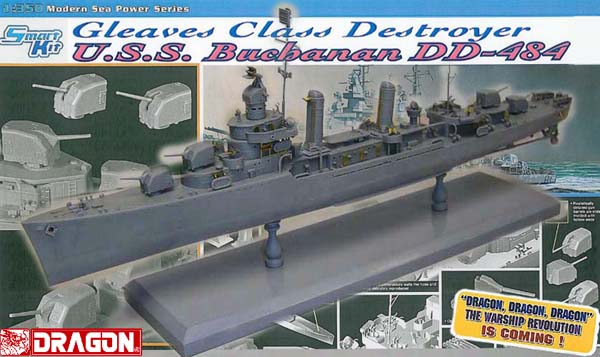
This new 1/350 smart kit from Dragon represents a major step forward
for injection molded ships. The ship was developed from plans retrieved
from the National Archives, and transformed into a CAD model using the
latest technology. See the preview
for some of the CAD images and test buildup of the kit. Dragon has been
listening to what ship modelers are asking for and this kit proves it.
They have engineered the parts to achieve higher levels of detail than
we are accustomed to in plastic. Extensive use of slide molding allows
for accurate shapes and complex details. Before you read my review, you
should know that I took an active part in the design of this kit and was
compensated for my efforts, therefor my opinions may be a bit biased.
|
|
| SPRUE A |
|
| The first sprue consists of most of the forward superstructure
parts. The bridge is composed of separate wings with interior bracing and
conduit detail molded on. The bridge win floor includes the underside bracing.
The doorways are molded with the doors as separate parts, the modeler can
mount them in the open or closed positions. The doorways are hollowed out
and it will be easy to open them up by removing the boss on the inside
walls. |
Click
images
to enlarge |
 |
| The bridge windows are not open due to mold limitations.
You can blacken these with a marker or drill them out yourself. Raised
wooden platforms for the 24" searchlight and pelorus mounts are also separate
parts to allow easy modification to other versions of the ship. The mushroom
vents are also separate parts as are the main deck hatchways. The funnels
are presented in two styles on this sprue and the B sprue. On this one
the molded on ladders are left off to allow for the included photo etch
ones to be used. The funnels are slide molded so you wont have to big seams
to fill. The funnel cap and base parts are designed so that the seams are
in easy to hide locations.
|
| SPRUE B |
|
| The second sprue includes most of the mid and aft superstructure parts.
You might notice the decks are lightly etches with a very fine diamond
plate pattern. The mast is finely detailed with position lights and other
items. The yardarm is separate as as the lower fighting lights. The funnel
caps feature hollow tops with molded on grills. Yes, these are a bit thick
for some modelers, but they will be easy to remove thanks to the smart
way this part is molded. The separate funnel piping will give them a more
realistic appearance. The Mk-37 gun director base is molded using slides
to eliminate the seams and allow for open slits. |
 |
|
|
| SPRUE C |
|
| This sprue features the deck propeller gear and lower hull. One of
the first things you will notice is that the deck is not flat. This is
because like real ships the deck is cambered to allow water to run off.
This may be a first for plastic ship models. The anchor chain is not molded
on so the modeler can easily add real chain or use the included brass photo
etch chain. The edges of the deck include the waterway that also acts as
a guide for those adding photo etch railing. |
 |
| The propellers are as thin as is practical for plastic.
The deck is also notched along the edge to allow the separate bits to be
easily placed and give a realistic appearance. The lower hull is
slide molded to allow for some very thin bilge keels. Test fitting shows
that the fit is very good. The area where the rudder mounts will need a
little smoothing as the clearance for the rudder is a bit exaggerated.
The rudder is separate and can be mounted at any angle.
|
| SPRUE D |
|
| This sprue include many of the weapons including quad and quintuple
torpedo mounts. Only the quintuple mounts are needed on this kit. The detailing
is very good with a separate control stand. The tubes are all loaded ready
to fire. The torpedo cranes are correct for Benson Gleaves class destroyers |
 |
| The 20 mm guns are extremely detailed and push the envelope
of injection molding capabilities. They are designed with separate shields,
gun base and barrels, and even ammo cans. The latter can be left off for
those who have problems with tiny parts. Additional photo etch details
and alternate shields are also provided. The real beauty of these guns
is that they can be elevated just like the real ones. A 5" practice loading
machine is provided with a separate base, gun assembly, and motor. A 1.1"
gun mount is also very detailed. The base, yoke, and gun barrel assemblies
are separate as are the sights and seats. Separate sights and seats are
also provided in photo etched brass. The gun barrels are as thin as possible
for injection molding.
|
| SPRUE E |
|
| Radar's and directors are presented on this sprue. The Mk-37 director
is molded in two parts again with the use of slides to preserve the detailing.
These are very detailed with crisp molding and sharp details. The torpedo
director features nice gauge face detailing and the Mk-51 directors are
awesome. The latter are molded with a separate base and yet another part
to benefit from the slide molding. I am very pleased with the way the Mk-12
radar screen mounting arms came out. This is one part that you wont need
to replace with photo etch. The plastic Mk-12 is not bad for plastic, but
serious molders will want to get the upgrade set for this kit and replace
them with the much more accurate versions provided in photo etch. The radar's
are typical for plastic and too thick for my taste. But the SA radar mount
is separate and will look great with a photo etch screens. Although not
used on the Buchanan in 42, an SG radar set is included complete with separate
base and antenna. |
 |
|
|
| SPRUE F |
|
| The strange looking parts on this sprue are actually forming tools.
Another smart feature of this kit. They are used to form the photo etch
life raft supports and the propeller guards. The latter is a great idea
as I'm sure I am not alone in having a hard time folding these to shape.
Use this tool to form near perfect shaped prop guards for your ship. Note,
the propeller guards are typical of those used on other USN destroyers,
so hold onto this tool it make come in handy for other projects. |
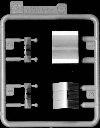 |
|
|
| SPRUE G (x2) |
|
| The 5" 38 gun turrets are presented in the correct single and double
knuckle style with all kinds of detail. The lower mounts feature extra
rivets on the roof panel along the extra knuckle to reinforce them from
the blast effects of the upper mount. I had thought the knuckle would be
more pronounced, but it is barely noticeable. The gun have the correct
offset for the gun. Such fine features as the louvers on the back are finely
molded. The base of the gun includes underside bracing and they fit nicely
with the upper mount reducing the amount of seams you will have to fill. |
 |
| You have a choice in gun barrels too. Canvas covered or
bare ones that can be elevated throughout the whole range of a real gun.
The ends are also hollowed. The amount of slide molding used on this sprue
shows how serious Dragon is in getting it right. These are undoubtedly
the best 5"38's ever done in plastic. They are even better than most resin
versions.
|
| SPRUE J |
|
| This sprue contains two 36" searchlight lenses. Just the lenses so
if you don't like the brittle nature of clear parts, you will appreciate
that the main part of that searchlight is good old gray plastic as shown
below on the K sprue. The surface of the lenses even has the cross lines
of the real ones. |
 |
|
|
|
|
| SPRUE K |
|
| This is the fittings sprue with everything from the ships boats to
the doors and davits. The ships boats are nicely done with separate inserts
for the seats and engine. Another insert allows you to convert the boat
to a covered version typical of those found on the Buchanan and other DD's.
The boats are designed to use a photo etch rudder assembly. |
 |
| Another first for ship modeling is the inclusion
of separate plastic doors. If you don't like working with photo etch, you
will like these. They allow you to model the doors open and while a little
thicker than PE, they look very nice. Optional bridge wing braces are included
for the non PE crowd. There are two types of searchlight bases are include
the tall ones found on the Buchanan and Aaron Ward, and a lower one typical
of those found on ships such as the McCalla. Floater net basket are provide
in two styles, empty and with molded floater nets. The K-guns parts are
great, they include separate launchers, stands with charges, and davits.
The davits are a little on the thick side as testing proved they broke
too easily when molded to scale thickness. Another nice detail is the pair
of smoke generators found on the stern. A three piece assembly with a very
realistic shape. The stern depth charge racks are well done but unfortunately
the seam falls in the middle of the cans where it is noticeable. Three
types of searchlights are provide. Swivel mount versions of the 12" searchlight
in a left and right hand version. Two 24" searchlights and a really nice
36" searchlight assembly that can be aimed realistically. Photo etched
seats are provided too. This will result in one smart looking assembly
when finished. The aft mast on this sprue even includes a hooded truck
light. The anchors are two pieces with a separate shank that allows the
fluke to pivot just like a real one. A two piece deck winch, Flag bags
and life rafts are among the other items on this sprue.
|
| SPRUE L |
|
| The upper hull is nicely done with lines that follow the hull lines
of the real ship. Even the characteristic rounded edge that tapers from
15" to zero at the bow is faithfully represented. I test fitting the decks
with this part with no problems. FYI the hull is split at the low water
mark to represent the ship in light or unloaded condition. |
 |
|
|
| SPRUE P |
|
A new base for this kit has been designed based on how most modelers
like to display their ships in full hull mode. The stands which resemble
lamp finales are even slide molded so they can be done without seams. Note
there are additional mounting hole locations in the base. So this base
can be used on future Dragon ships. Hmmmmm  |
 |
|
|
| PHOTOETCH |
|
| Two photo etch frets are included with the finer details
that just can't be done in plastic. The first fret includes the photo etched
details mention in the previous text as well as lots of others. Fore funnel
platforms with relief etched decks, direction finder loop, inclined ladders,
and aft mast details. The mast ladder not only helps add detail, it strengthens
the joint of the upper and lower parts, smart. The second fret includes
the optional doors. These are nice and are relief etched on both sides.
Three types are included 60" 66" and bridge doors.
Another included part is the shields for the skylookouts. These are
pre formed so you wont have to do it yourself. |
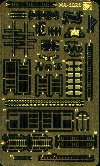 |
 |
 |
|
|
| DECALS |
|
| Another smart feature is the walkway decals printed by
Cartograf. These represent the anti-skid rubber pads that were often applied
to US Navy ship. Since this was a detail that was usually added by the
crew, the arrangement and path tended to be different on each ship. There
are some extra sections so you can adapt the walkway to fit other ships
too. Hull numbers are done in the typical USN style. Draft markings are
black above the boot topping line, and white below.
A second decal sheet is provided for the flags printed on self adhesive
vinyl. These include the straight and wavy flags, and a token amount of
signal flags. |
 |
 |
|
|
| INSTRUCTIONS |
|
| The instructions are an eight page booklet showing the
assembly in a step by step process that is easy to follow. A full size
camo drawing is provided to help you paint the MS-12 modified camo scheme.
Or you can also paint the ship in a plain Ms-21 scheme for her 43 appearance.
If you plan on painting your ship, then I would change the order of assembly
as it is much easier to attach the decks to the hull without all the fine
parts added. |
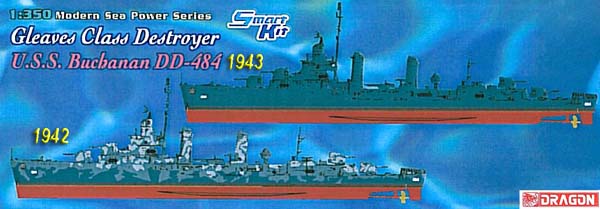
|
| BONUS CREW MEMBERS |
|
| If you read my April
Fools Day, 2008 review then you probably thought that Joe and his friends
were a work of fantasy. But the joke is on you because these guys are real
and are they are very detailed. Six different crew are provided with realistic
poses and features. Since they are plastic, you can easily modify the pose
to suit your needs. These guys are head and shoulders above the flat lifeless
forms available in other sets. Yes, these will eventually be available
in a separate set, but for now the only way you are going to get these
guys is to get your own USS Buchanan. |
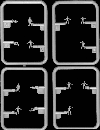 |
|
|
| CONCLUSIONS |
|
 Having
worked with Dragon on this new kit, my opinions are somewhat biased. However
I have been listening to what modelers want for many years and this proves
that Dragon is also listening. I have heard armor and figure modeler rant
and rave about Dragon kits for years and was I am thrilled that they are
now elevating ships to that level. This kit marks a new direction for Dragon
in the 1/350 ship world. This smart kit features smart molding, smart detailing,
and smart options. Not only is this a new state of the art kit, but it
is also only the beginning. You can expect more great ships like this in
the future. It is available now for only $39.99 at Dragon
USA. A fantastic price when you consider all that you get. For a limited
time you can add an extra $2 and you can get the bonus upgrade set that
includes railings and pre-formed Mk-12 radar screens. Having
worked with Dragon on this new kit, my opinions are somewhat biased. However
I have been listening to what modelers want for many years and this proves
that Dragon is also listening. I have heard armor and figure modeler rant
and rave about Dragon kits for years and was I am thrilled that they are
now elevating ships to that level. This kit marks a new direction for Dragon
in the 1/350 ship world. This smart kit features smart molding, smart detailing,
and smart options. Not only is this a new state of the art kit, but it
is also only the beginning. You can expect more great ships like this in
the future. It is available now for only $39.99 at Dragon
USA. A fantastic price when you consider all that you get. For a limited
time you can add an extra $2 and you can get the bonus upgrade set that
includes railings and pre-formed Mk-12 radar screens. |
 |
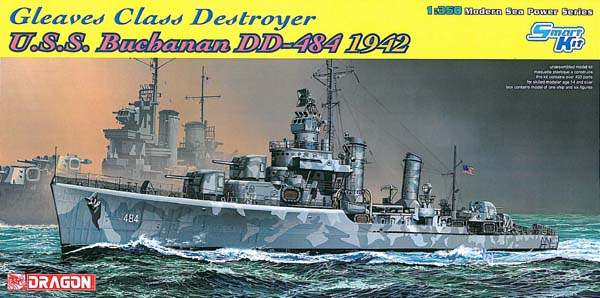
















 Having
worked with Dragon on this new kit, my opinions are somewhat biased. However
I have been listening to what modelers want for many years and this proves
that Dragon is also listening. I have heard armor and figure modeler rant
and rave about Dragon kits for years and was I am thrilled that they are
now elevating ships to that level. This kit marks a new direction for Dragon
in the 1/350 ship world. This smart kit features smart molding, smart detailing,
and smart options. Not only is this a new state of the art kit, but it
is also only the beginning. You can expect more great ships like this in
the future. It is available now for only $39.99 at Dragon
USA. A fantastic price when you consider all that you get. For a limited
time you can add an extra $2 and you can get the bonus upgrade set that
includes railings and pre-formed Mk-12 radar screens.
Having
worked with Dragon on this new kit, my opinions are somewhat biased. However
I have been listening to what modelers want for many years and this proves
that Dragon is also listening. I have heard armor and figure modeler rant
and rave about Dragon kits for years and was I am thrilled that they are
now elevating ships to that level. This kit marks a new direction for Dragon
in the 1/350 ship world. This smart kit features smart molding, smart detailing,
and smart options. Not only is this a new state of the art kit, but it
is also only the beginning. You can expect more great ships like this in
the future. It is available now for only $39.99 at Dragon
USA. A fantastic price when you consider all that you get. For a limited
time you can add an extra $2 and you can get the bonus upgrade set that
includes railings and pre-formed Mk-12 radar screens. 
